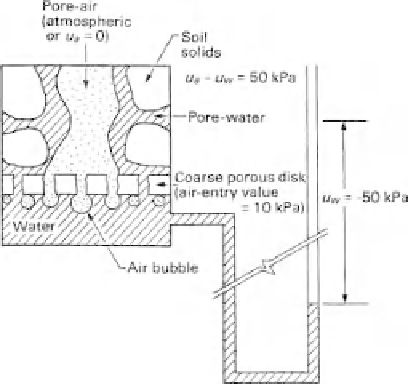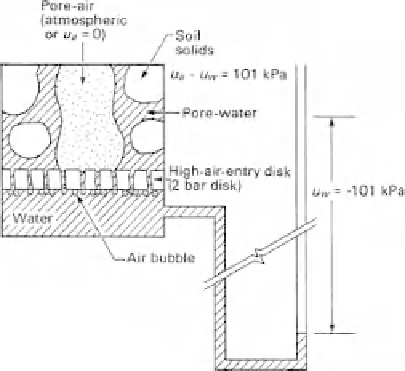Environmental Engineering Reference
In-Depth Information
in the laboratory using triaxial and direct shear apparatuses
that have been modified for testing unsaturated soils.
The
c
and
φ
parameters can be measured using satu-
rated soil specimens. The equipment and techniques used
for testing saturated soils are well documented by Bishop
and Henkel (1962) and Head (1986). The tests on unsatu-
rated soil specimens are primarily performed to obtain the
φ
b
soil parameter. General procedures for testing unsaturated
soils using a modified triaxial and direct shear apparatus
are described in this topic. Computations and data reduction
associated with analyzing the test results are similar to those
required for saturated soils.
ceramic disk. However, free air cannot flow through the disk
unless a limiting air-entry value is exceeded. The limiting
value of air pressure that can be applied to the ceramic disk
is called the “air-entry value.” Even prior to exceeding the
air-entry value of the disk, it is possible for air to dissolve in
the water in the ceramic disk and then slowly diffuse through
the water in the disk. The ceramic disk serves as a separator
between the air and water phases, but unfortunately it is not
a “perfect” separator.
Figure 11.26 illustrates the direct measurement of pore-
water pressure relative to atmospheric air pressure condi-
tions (i.e.,
u
a
=
0). The soil specimen is placed on top of a
saturated porous disk and a U-tube is connected to the water
compartment below the disk. The U-tube can be moved up
11.4 SPECIAL EQUIPMENT DESIGN
CONSIDERATIONS
Conventional triaxial and direct shear equipment requires
that a number of modifications be made to the equipment
prior to attempting to test unsaturated soils. Several factors
related to the nature of an unsaturated soil must be consid-
ered when modifying the equipment. The presence of air and
water in the pores of the soil causes the testing procedures
and techniques to be considerably more complex than when
testing saturated soils. The primary modifications are associ-
ated with the independent measurement and/or control of the
pore-air and pore-water pressures. The pore-water pressure
is usually negative (gauge) and can result in cavitation of
the water in the measuring system when the water pressures
are too low.
Triaxial testing methods are defined on the basis of the
drainage conditions imposed following the application of the
confining pressure
σ
3
and the drainage conditions imposed
during the application of the deviator stress,
σ
1
−
σ
3
. For
undrained testing conditions, the pore fluid (i.e., pore-air
or pore-water) is not allowed to drain. Excess pore-air and
pore-water pressures developed during undrained loading
conditions must be independently measured.
For drained testing conditions, the pore-air and pore-water
pressures are allowed to drain to prescribed pressures
imposed on the top or bottom of the soil specimen. Volume
changes associated with the pore fluid flow during a drained
test should be measured.
(a)
11.4.1 Axis Translation Technique
The axis translation technique is commonly used when test-
ing unsaturated soils in the laboratory. The axis translation
technique has proven to be particularly useful for controlling
matric suction values in excess of 100 kPa. The pore-water
pressure
u
w
in an unsaturated soil can be measured or con-
trolled through use of a ceramic disk with fine pores (i.e.,
high-air-entry disks). The functionality of the ceramic disk
can be observed while applying various differential air and
water pressures across the disk.
The ceramic disk is hydrophilic and as such has a high
affinity for water. Water can move into and through the
(b)
Figure 11.26
Direct measurement of pore-water pressure in an
unsaturated soil specimen (not to scale): (a) air movement through
the porous disk when its air-entry value is exceeded; (b) air dif-
fusion through the high-air-entry disk and water cavitation in the
measurement of matric suction.











Search WWH ::

Custom Search